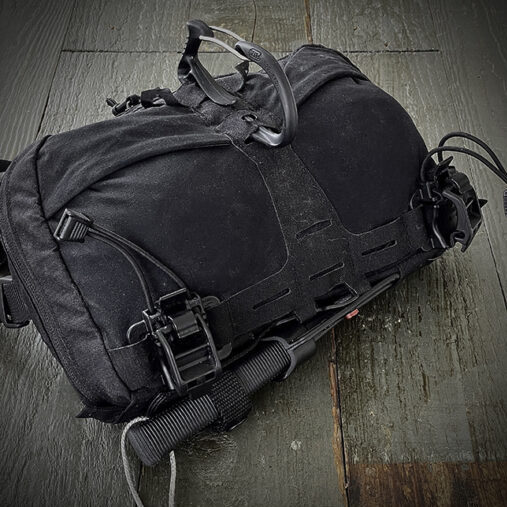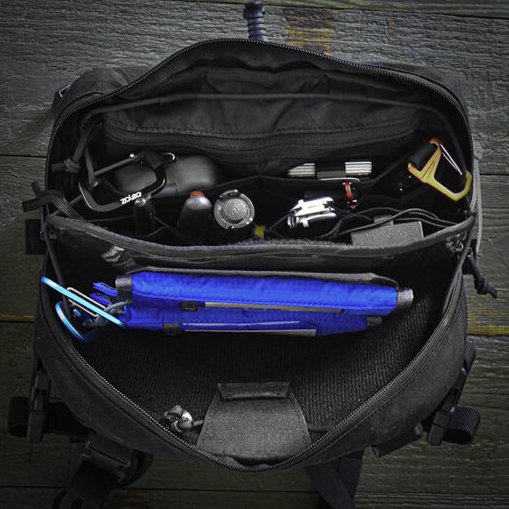Chestpack
 |  |
I use a chestpack, al-the-time and everywhere, with all the essentials, should something bad happen.
Default, my chestpack contains the following items:
– Zoleo PLB & Satellite Messenger
– Fenix PD32 Flashlight
– Aviator card wallet
– Kase Wolverine K100 camera filter set
– Fällkniven A1x knife
– Leatherman Tools
– Suunto Compass
– Camera Batteries & Memory Cards
– Remotes for my cameras
– GoPro wrenches
– Mini Towl / Lens cloth
– Headnet
– Sharpie
– iPhone 12 Pro
Abilities and knowledge
BEFORE YOU SET OFF ON A HIKE, IT’S IMPORTANT TO KNOW THE LEVEL OF DIFFICULTY SO YOU CAN KIT YOURSELF OUT PROPERLY, ALLOW SUFFICIENT TIME TO COMPLETE THE HIKE AND, MOST IMPORTANTLY, ASSESS WHETHER YOU’RE CAPABLE OF DOING IT!
SAC hiking scale:
| LEVEL | PATH | TERRAIN | REQUIREMENTS | MARKING SWISS WALKING PATHS (SWW) | MARKING GERMAN ALPINE CLUB (DAV) |
|---|---|---|---|---|---|
| T1 Hiking | Well developed, signposted and marked. Somewhat exposed places very well secured. | Flat or slightly inclined. No danger of falling with appropriate behaviour. | No steady footing necessary. Can be walked in trainers. Navigation without a map possible. | Yellow | Blue |
| T2 Mountain hiking | Continuous route and passage marking. | Steep in parts. Danger of falling not excluded. | Some steady footing Trekking shoes recommended. Basic navigation skills. | White-red-white | Blue or red |
| T3 Challenging mountain hiking | A footpath is usually available. Exposed places mostly secured with ropes or chains. | Partially exposed areas with danger of falling, gravel plains, pathless steep terrain. | Good steady footing Good trekking shoes. Average navigation skills. Basic Alpine experience. | White-red-white | Red |
| T4 Alpine walking | Path not necessarily available. Sometimes need to use hands to keep going. | Mostly exposed. Tricky grass heaps, rocky slopes, simple firn fields and snow covered glacier passages. | Familiarity in exposed terrain. Stable trekking shoes. Terrain assessment and good navigation skills. Alpine experience. | White-blue-white | Red or black |
| T5 Challenging Alpine walking | Often without a path. Individual, simple climbing sections. | Exposed. Challenging terrain, steep rocky slopes, snow covered glaciers and firn fields with danger of slipping. | Mountaineering boots. Secure terrain assessment and very good navigation skills. Good Alpine experience also in high Alpine terrain. Elementary knowledge in handling a pickaxe and rope. | White-blue-white | Black |
| T6 Difficult Alpine walking | Mostly without a path and unmarked. Climbing sections up to II. | Often very exposed. Tricky rocky slopes, snow covered glaciers with increased danger of slipping. | Excellent navigation skills. Proven alpine experience and familiarity with alpine equipment. | Mostly unmarked | Mostly unmarked |
SAC mountaineering scale
| FRENCH | ENGLISH | ROCK | UIAA LEVEL | FIRN & GLACIERS |
|---|---|---|---|---|
| F Facile | Easy | Simple walking terrain (boulder, stone ridge) | From I | Simple firn slopes, hardly any crevasses |
| PD Peu difficile | Not very hard | Mostly walking terrain, increased step safety necessary, climbing sections clearly arranged and unproblematic. | From II | Mostly less steep drops, short passages steep, few crevasses |
| AD Assez difficile | Fairly hard | Repeated securing necessary, longer and more exposed climbing areas | From III | Steeper slopes, many crevasses, small Bergschrund (mountain crevasse) |
| D Difficile | Hard | Good navigational sense and efficient rope handling required, long climbing sections, usually belaying | From IV | Very steep slopes, many crevasses, large Bergschrund |
| TD Très difficile | Very hard | Continuous belaying in difficult places, persistently challenging climbing | From V | Continuously steep terrain |
| ED Extremement difficile | Extremely hard | Wall passages that require great commitment | From VI | Very steep and vertical places, ice climbing required |
| ABO Abominable difficle | Incredibly hard | Extremely steep, partly overhanging wall passages | VII and more | Extreme ice climbing |
CLIMBING SCALE (UIAA)
| DIFFICULTY | DESCRIPTION (ROCK CLIMBING) |
|---|---|
| I Slight difficulties | Simplest form of rock climbing (not easy walking terrain!) Hands required for balance. Beginners secured to the rope. A head for heights is required. |
| II Moderate difficulties | Movement with simple combinations of steps and handles (three-point-technique). |
| III Medium difficulties | Intermediate securing at exposed points is recommended. Vertical places or overhangs with good grip require physical effort. |
| IV Great difficulties | Substantial climbing experience required. Longer climbing sections usually require several intermediate safety devices. |
| V Very great difficulties | Increasing number of intermediate safety devices. Greater physical requirements, climbing technique and experience. |
| VI Extreme difficulties | Above-average ability and good level of training required. Great exposure, often combined with small sites. Good conditions are usually a prerequisite for conquerability. |
| VIII Exceptional difficulties | Only achievable through increased training and improved equipment. Acrobatic climbing ability and command of sophisticated safety technology are essential. |
| VIII to XI+ | A verbal definition is not possible here. This is a further increase in the difficulties to be faced, which place ever greater demands on climbing skills and physical and mental performance. |
First Aid:
Know Basic Life Support and have a current first aid certificate!
